Help Me, Laptop! Razer Blade or Asus ROG Zephyrus?
Gaming laptops have been getting progressively thinner over the years -- sometimes at the expense of power. However, Nvidia's new Max-Q design laptops are proving that you might actually be able to have a slim, lightweight system that doesn't skimp on performance. Which brings us to our forum member JasonSno, who's trying to make a decision between the Razer Blade and the Asus ROG Zephyrus.

Jason writes that the system will be primarily used for school, with some gaming on the side. He goes on to cite the better display, thermals and GPU in the Zephyrus. However, he's concerned about battery life and is open to suggestions. Let's help him choose.
Design
The Blade and the Zephyrus are stunning systems in their own right. I am a sucker for Razer's ebony CNC aluminum chassis with its hypnotic glowing tri-snake logo and glittering Chroma keyboard. However, the way the light glints off the Zephyrus' jet-black brushed-aluminum frame is tantalizing in its own right. Plus, the way that rear exhaust panel lowers as the lid is closed is wickedly awesome.
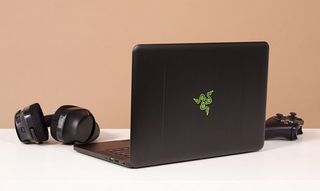
For such a relatively thin laptop, the Zephyrus has quite a few ports, including four USB 3.0 ports, a Thunderbolt 3 port, an HDMI 2.0, a headset jack and a Kensington secure lock slot. The Blade has a near-identical assortment of ports, except it has only three USB 3.0 ports.
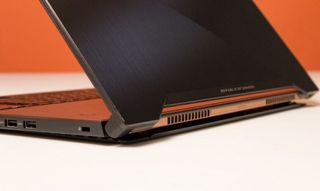
At 4.2 pounds, the 13.6 x 9.3 x 0.7-inch Blade is a bit lighter and smaller than the 5-pound, 14.9 x 10.3 x 0.7 Zephyrus. That might be a benefit to Jason if he's planning to use the system in class.
Winner: Razer Blade is noticeably lighter.
Display
Both the Zephyrus and the Blade have 1920 x 1080 matte displays that are evenly matched when it comes to vividness. Able to reproduce 115 percent of the sRGB color gamut, the Blade's 14-inch panel barely edged out the Zephyrus (114 percent). The Blade also proved to be brighter, averaging 289 nits, compared with the Zephyrus' 276 nits.
Stay in the know with Laptop Mag
Get our in-depth reviews, helpful tips, great deals, and the biggest news stories delivered to your inbox.
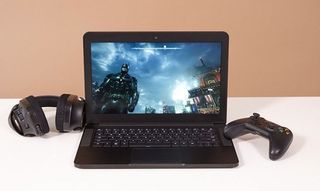
It's not all bad for the Zephyrus, since its 15.6-inch screen also features Nvidia's G-Sync technology with 120 Hertz refresh rate, which should ensure smoother rendering and less input lag. But what the Blade lacks in G-Sync, it makes up for with a 4K touch-screen option. Keep in mind, you'll have to shell out an additional $500 for that luxury.
Winner: Razer Blade lacks G-Sync, but it has a brighter display and a 4K option.
Gaming Performance
Jason is considering the Zephyrus configuration with the Nvidia GeForce GTX 1070 (Max-Q) GPU. However, I've only reviewed the 1080 (Max-Q) model to date, so the performance is tipped a bit in Asus' favor.
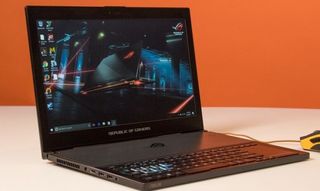
During the Rise of the Tomb Raider benchmark, the Zephyrus notched 58 frames per minute (fpm) on Very High settings at 1080p. The Blade and its GTX 1060 GPU managed to reach 43 fps, which is above the thin-and-light average of 38 fpm and our playability threshold of 30 fpm. The Blade came close to matching the Zephyrus on the Hitman test, with the former obtaining 60 fps and the latter 68 fps. But the Asus asserted its dominance on the Grand Theft Auto benchmark, achieving 78 fps, while the Blade delivered a respectable 44 fps.
MORE: The Best Gaming Laptops
Thanks to their graphics cards, each laptop can support an Oculus Rift or HTC Vive. The Razer scored a solid 6 on the SteamVR Performance test, while Zephyrus hit 10.7, which is only a few points shy of the maximum score (11).
Winner: Asus ROG Zephyrus has better gaming performance.
Performance
Although Jason plans to do some gaming on his new system, it will also have to work as a multitasking productivity machine. With their 2.8-GHz Intel Core i7-7700HQ processors, both the Razer and the Asus are up to the task.
When we ran Geekbench 4, a synthetic performance test, the Zephyrus notched 13.391. The Blade managed to eke out a win with 13, 684. On the OpenOffice Spreadsheet Macro, the Blade maintained its lead, matching 20,000 names and addresses in 3 minutes and 31 seconds, slightly faster than the Zephyrus' 3:43.
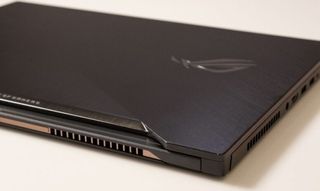
But the Asus got some revenge during the File Transfer test, where its 512GB M.2 PCIe NVMe SSD duplicated 4.97GB of mixed-media files in a scorching 10 seconds. That translates into a transfer rate of 508.9 megabytes per second. The Blade and its 256GB PCIe produced a respectable 203 MBps.
Winner: Tie. While the Blade had some better scores, the Zephyrus has a much faster SSD.
Battery Life
If Jason is thinking of using the Zephyrus in class, he better scout the classroom in advance for any available plugs. The laptop only lasted 1 hour and 57 seconds on our battery test, which consists of continuous web surfing over Wi-Fi. The Blade lapped the Asus several times, lasting 7:45.
MORE: Laptops with the Longest Battery Life
Winner: Razer Blade lasts much longer on a charge.
Heat
Since the Blade and the Zephyrus are made of aluminum, they can both get a bit hot under the collar -- especially during a gaming session. After 15 minutes of playing The Witcher 3: Wild Hunt, the Blade's touchpad measured 106 degrees Fahrenheit. The center of the keyboard and bottom were even hotter at 111 and 119 degrees. All of those temperatures are above our 95-degree comfort threshold.
Using its Active Aerodynamics System (AAS), a system comprised of several pieces of hardware working in tandem, the Zephyrus stayed surprisingly cool. Fifteen minutes of fighting griffins in Witcher 3, and the touchpad, center and bottom registered 88, 92 and 97 degrees, respectively. That's not to say that the Asus isn't a hot tamale -- it is -- the system just pushes the majority of its hot air out of that nifty rear vent. Temperatures there reached 121 degrees.
Winner: Asus Zephyrus stays a bit cooler.
Value
Razer offers several configurations of the Blade, starting with the $1,899 base model that features a 2.8-GHz Intel Core i7-7700HQ processor, 16GB of RAM, a 256GB PCIe SSD, an Nvidia GeForce GTX 1060 GPU and a 1920 x 1080 display. The 512GB and 1TB SSD versions of the laptop are available for $2,099 and $2,499, respectively.

The company also offers two other configurations with 4K panels: a $2,399 model with a 512GB PCIe SSD, and a top-of-the line 1TB PCIe SSD for $2,799.
The entry-level Zephyrus features a 2.8-GHz Intel Core i7-7700HQ CPU, 16GB of RAM, a 256GB PCIe NVMe SSD, an Nvidia GeForce GTX 1070 (Max-Q) GPU and a 1080p Nvidia G-Sync panel with 120Hz refresh rate for $2,299. The $2,699 version bumps up the storage to 512GB with a GTX 1080 (Max-Q) GPU.
Winner: Razer Blade is less expensive.
Final Verdict
Both the Razer Blade and Asus ROG Zephyrus are great choices as gaming laptops. In fact, I'd fully recommend the Zephyrus for its performance, G-Sync display and thermal management for gaming. However, if the primary use is going to be for school, I'm going to go with the Razer Blade for Jason. Not only is the Blade lighter, it's also cheaper and has a much longer battery life than the Zephyrus. And, yes, Jason, I know you're willing to look high and low for a power outlet, but when school's involved, I don't want to take any chances. So go with the Blade.
Credit: Laptop Mag

Sherri L. Smith has been cranking out product reviews for Laptopmag.com since 2011. In that time, she's reviewed more than her share of laptops, tablets, smartphones and everything in between. The resident gamer and audio junkie, Sherri was previously a managing editor for Black Web 2.0 and contributed to BET.Com and Popgadget.